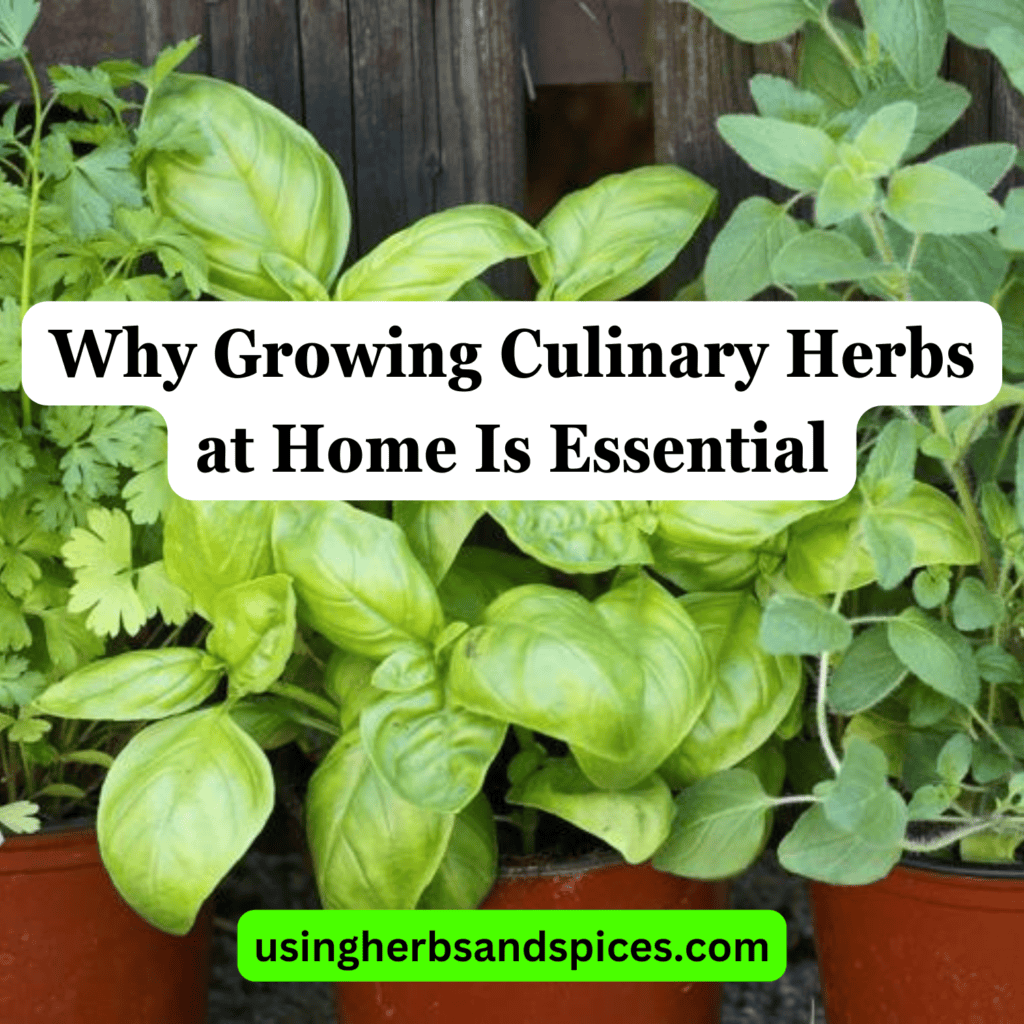If you’re enthusiastic to elevate your culinary game, incorporating the 12 essential herbs into your kitchen arsenal is a move you won’t regret. Each herb, from the aromatic versatility of basil to the fresh, citrusy punch of cilantro, offers a unique flavor profile that can transform an ordinary dish into something extraordinary. But how do you pair these herbs with the right ingredients to fully harness their culinary power? The secret lies in understanding their individual characteristics and the subtle ways they can enhance your dishes. Let’s explore how these flavorful herbs can become your secret weapon in the kitchen, leaving you curious about the possibilities each one holds.

Key Takeaways
- Basil adds a slightly sweet, peppery essence, perfect for enhancing the flavor of fresh dishes and sauces.
- Cilantro offers a distinct, citrusy punch to culinary creations, ideal for adding a vibrant, antioxidant-rich flavor.
- Rosemary’s piney warmth and woody aroma can elevate roasts, stews, and even cocktails with its versatile flavor.
- Thyme’s subtle earthiness pairs well with proteins, adding depth to dishes without overpowering other ingredients.
- Oregano’s bold, robust flavor brings a depth of earthiness, making it a versatile herb that enhances various cuisines with its unique essence.
Basil: Aromatic Versatility
Basil, with its lush, fragrant leaves, effortlessly elevates the flavor profile of any dish it graces, embodying aromatic versatility at its finest. When you’re in your kitchen, experimenting with flavors, the inclusion of basil can transform the mundane into the extraordinary. Its vibrant, slightly sweet, yet peppery essence makes it a cornerstone in culinary herb gardens and a beloved staple in kitchens around the world.
Imagine whipping up a classic basil pesto, where basil’s robust character is the star. This simple yet profound sauce, with its rich blend of basil, Parmesan, pine nuts, garlic, and olive oil, not only pairs perfectly with pasta but also brings a lively punch to sandwiches and pizzas. Its preparation is a culinary tradition, connecting you to generations of traditional Italian cooking, and inviting you into a community of fellow basil aficionados.
Moreover, basil’s adaptability extends into the world of mixology. Herbal cocktails, infused with the fresh, aromatic notes of basil, offer a sophisticated twist to your beverages. Whether muddled into a gin basil smash or floating in a strawberry basil margarita, basil imbues drinks with a delightful complexity that’s hard to match. Through these creative uses, basil not only enhances your culinary endeavors but also fosters a sense of belonging among those who cherish its unique flavor and aroma.
Cilantro: Fresh and Citrusy
You’ve likely noticed cilantro’s distinct, citrusy punch in many dishes, but its benefits extend far beyond flavor. Let’s explore how this vibrant herb not only enhances your meals but also boosts your health with its surprising array of nutrients.
I’ll guide you through expert tips to masterfully incorporate cilantro into your cooking, ensuring every dish sings with freshness.
Cilantro Health Benefits
Cilantro, with its fresh and citrusy flavor, offers a treasure trove of health benefits that can greatly enhance your well-being. While it’s beloved by many, it’s also important to be aware of a cilantro allergy, which, though rare, can affect some individuals. Surprisingly, its remarkable properties start right from seed germination, showcasing the plant’s inherent vitality and the potential health benefits it carries.
- Rich in antioxidants: Cilantro is packed with antioxidants that help protect your body from oxidative stress and reduce inflammation.
- Natural detoxifier: It has been shown to bind to toxic metals and facilitate their removal from the body, acting as a natural detoxifier.
- Supports heart health: Incorporating cilantro into your diet can improve heart health by reducing bad cholesterol levels and increasing good cholesterol.
Cooking Tips: Cilantro
To elevate your culinary creations, incorporating cilantro can add a fresh and citrusy dimension that often transforms a good dish into an unforgettable one. Mastering cilantro storage is essential for preserving its vibrant flavor.
Wrap it in a damp paper towel and store it in your refrigerator in an airtight container. This method keeps it fresh longer, ensuring you always have that zesty kick at hand.
If you find yourself out of cilantro, don’t fret. There are suitable cilantro substitutes that can save your dish. Flat-leaf parsley mixed with a squeeze of lime offers a comparable freshness, while basil can introduce an interesting, albeit different, aromatic quality.
Embrace these tips, and you’ll secure your place as a culinary artist among your peers, infusing your dishes with the unique essence of cilantro.
Rosemary: Piney Warmth
Amidst the aromatic staples in your kitchen, rosemary introduces a piney warmth that transforms ordinary dishes into culinary masterpieces. This robust herb, with its needle-like leaves and woody aroma, isn’t just a flavor enhancer but a bridge to creating moments of connection through food.
Whether you’re harvesting rosemary fresh from your garden or using it dried from your pantry, the key to revealing its full potential lies in how you incorporate it into your cooking.
Rosemary’s versatility extends beyond traditional roasts and stews. Have you considered rosemary cocktails? Imagine the surprise and delight of your guests when you serve a rosemary-infused gin cocktail, where the herb’s distinct flavor complements the botanicals in the gin, creating a drink that’s both invigorating and sophisticated.
To help you make the most of this aromatic herb, consider these three tips:
- Experiment with rosemary harvesting: Freshly picked rosemary has a vibrancy that dried versions can’t match.
- Incorporate into cocktails: Elevate your home bartending skills by infusing rosemary into syrups or directly into spirits.
- Use sparingly: Due to its strong flavor, start with a small amount and adjust to taste.
Thyme: Subtle Earthiness
As you explore thyme’s role in culinary arts, you’ll find its subtle earthiness brings a unique depth to dishes. Understanding its flavor profile is key, especially when you’re pairing it with proteins to elevate your meal.
And if you’re keen on capturing the freshest essence, growing your own thyme could be a rewarding venture to contemplate.
Thyme’s Flavor Profile
Thyme’s flavor profile, marked by a subtle earthiness, adds a complex layer to dishes, enhancing them with a whisper of the Mediterranean. This herb, with its tiny leaves, brings a gentle hint of the wild, a touch of forest and floral notes that can elevate your cooking from simple to sophisticated. As you begin thyme cultivation, you’ll find it’s a resilient herb, thriving with minimal fuss, and its preservation is straightforward, ensuring you can enjoy its flavor year-round.
- Explore Thyme Cultivation: Learn to grow thyme in your garden or windowsill for the freshest flavors.
- Master Thyme Preservation: Discover drying or freezing methods to keep thyme flavorful.
- Experiment with Uses: Add thyme to soups, sauces, and bread for an instant flavor upgrade.
Pairing With Proteins
When pairing proteins with herbs, incorporating thyme’s subtle earthiness can transform your meat dishes from ordinary to extraordinary, creating a symphony of flavors on your palate. Imagine the depth it adds to meat marination, tenderizing beef, pork, or lamb while infusing them with a whisper of the forest floor.
The magic doesn’t end there; thyme’s versatility shines in seafood seasoning, where its gentle touch complements the delicate nature of fish and shellfish without overpowering their natural taste. Each sprinkle or sprig invites you into a world where each bite is a story, a perfect harmony of nature’s gifts and culinary craftsmanship.
Let thyme be your secret ingredient, the silent note that elevates the song of your cooking to new heights, making every meal a moment of belonging.
Growing Your Own Thyme
Having explored thyme’s ability to enhance protein dishes, it’s now time to consider growing your own in order to guarantee a continuous supply of its subtle earthiness for your culinary creations.
- Soil Preparation: Thyme thrives in well-drained soil with a neutral to slightly alkaline pH. Incorporating organic matter or compost guarantees healthy growth.
- Container Gardening: Perfect for those with limited space, thyme grows excellently in pots. Make sure your container has good drainage holes to prevent water logging.
- Sunlight and Watering: Position your thyme in a spot that receives at least six hours of sunlight daily. Water it sparingly; thyme prefers drier conditions over wet feet.
Oregano: Bold and Robust
Oregano’s bold and robust flavor elevates your dishes with a depth of earthiness that’s hard to match. This cherished herb, woven into the fabric of culinary history, carries with it a legacy dating back to ancient civilizations. They revered it not just for its aromatic qualities but also for its medicinal properties. As you sprinkle oregano into your next dish, remember, you’re partaking in a tradition that spans millennia.
Drying techniques are vital in harnessing oregano’s full potential. Unlike other herbs, oregano intensifies in flavor once dried, offering a more concentrated essence. Hang bunches in a warm, airy space away from direct sunlight to preserve its potent oils. This method guarantees that the leaves retain their aromatic oils, providing a burst of flavor that’s incomparable.
Embracing oregano in your cooking isn’t just about adding a herb; it’s an invitation to explore the rich tapestry of flavors that have delighted palates for generations. Whether it’s infusing a hearty stew or sprinkling atop a fresh salad, oregano’s versatility is unmatched. Let it inspire you to experiment boldly in your culinary endeavors, making every meal a tribute to the enduring allure of this remarkable herb.
Parsley: Bright and Fresh
You’ve likely encountered parsley as a garnish, but it’s much more than a pretty plate decoration. Exploring its varieties opens up a world of flavor, from the robust Italian flat-leaf to the curly type that’s not just for show.
Understanding its culinary uses and health benefits can transform your cooking, infusing dishes with a bright, fresh taste that elevates them from good to gourmet.
Parsley Types Varieties
Parsley, a versatile culinary herb, comes in two main varieties: the robust flat-leaf and the delicate curly-leaf, each adding its unique zest to dishes. Understanding the nuances of each can elevate your cooking and guarantee you’re making the most of this vibrant herb.
- Parsley Cultivation: Flat-leaf parsley is often easier to cultivate in your garden or a sunny window, thriving in well-drained soil. Curly-leaf parsley can be more forgiving in slightly cooler climates.
- Parsley Storage: To keep either variety fresh, wrap them in a damp paper towel and refrigerate or snip the ends and place them in a glass of water.
Embrace these varieties in your kitchen to infuse your dishes with a burst of freshness and color, truly making each meal an experience.
Cooking Uses Tips
After exploring the types and cultivation of parsley, let’s focus on how to incorporate this bright and fresh herb into your culinary creations effectively.
Mastering seasoning techniques with parsley can transform your dishes from good to gourmet. Begin by integrating parsley towards the end of cooking to preserve its vibrant color and delicate flavor.
For a deeper connection with your food, experiment with spice combinations that complement parsley’s unique profile. Think about blending it with garlic and lemon zest for a Mediterranean flair or mixing it with chilies for a kick of heat.
Parsley isn’t just a garnish; it’s a gateway to elevating your culinary skills, inviting you to explore the nuances of flavor that make every dish feel like a shared journey.
Health Benefits Highlighted
Beyond enhancing your dishes with its vibrant flavor, parsley also packs a nutritional punch that can greatly boost your health. This herb isn’t just a garnish; it’s a powerhouse of benefits. When you weave parsley into your cooking, you’re not only elevating the taste but also incorporating a boost of herbal antioxidants that can rejuvenate your body from the inside out.
- Rich in vitamins: Parsley is loaded with vitamins A, C, and K, essential for maintaining good vision, immune function, and bone health.
- Herbal antioxidants: Offers a range of antioxidants that protect your cells from damage and support overall health.
- Supports heart health: The high content of vitamin K in parsley supports heart health and improves bone density.
Dill: Delicate Anise Flavor
Diving into the world of herbs, you’ll find that dill, with its delicate anise flavor, uniquely enhances dishes ranging from seafood to salads. This feathery herb doesn’t just bring freshness to your cuisine; it creates a sense of belonging, connecting you to centuries-old culinary traditions. Understanding dill preservation is crucial, as its fragrant oils are best preserved when the herb is frozen or dried, ensuring you can enjoy its flavor year-round.
Exploring dill varieties introduces you to a world where each type brings its own character to dishes. Whether you’re using the feathery leaves of ‘Bouquet’ for a soft, aromatic touch or the more robust ‘Mammoth’ for pickling, knowing your varieties enriches your cooking with precision and creativity. Dill’s versatility doesn’t stop at type; its seeds offer a stronger, more concentrated taste, perfect for bread, soups, and pickles.
Incorporating dill into your culinary repertoire isn’t just about adding flavor; it’s about crafting experiences, creating moments where every bite tells a story of tradition, taste, and the tender care of home cooking.
Mint: Cool Freshness
Shifting our focus to mint, you’ll discover its invigorating cool freshness breathes life into everything from teas to desserts, offering a versatile palette cleanser that’s as rejuvenating as it’s soothing. When you infuse your dishes with mint, you’re not just adding a layer of flavor; you’re inviting a burst of revitalizing, energizing energy that transforms the simplest meal into a memorable feast. Mint’s vibrant, clean taste pairs wonderfully with both sweet and savory dishes, making it a staple in kitchens around the world.
Imagine sipping on mint tea, its soothing aroma enveloping you, offering a moment of calm in your busy day. Or picture the sheer delight of mint ice cream, where the herb’s crispness cuts through the sweetness, creating a perfectly balanced treat that dances on your tongue. Mint’s versatility doesn’t stop at these classics; it’s also a star in salads, cocktails, and even grilled meats, bringing a breeze of freshness that elevates every bite.
- Mint tea: A comforting, aromatic beverage that relaxes and revitalizes.
- Mint ice cream: A classic dessert that balances sweetness with a cool, minty kick.
- Adding mint to salads: A simple way to introduce a revitalizing crunch and vibrant flavor.
Sage: Peppery Sweetness
Turning our attention to sage, you’ll find its peppery sweetness offers a vital layer of flavor to dishes, elevating them with a warm, aromatic depth. This herb isn’t just a culinary treasure; it’s steeped in rich folklore and tradition, making it a fascinating addition to your kitchen repertoire.
Sage harvesting plays an essential role in capturing its essence. The best time to harvest sage is during the late morning when the dew has evaporated, ensuring you get the most potent aroma and flavor. This technique, passed down through generations, is a reflection of the deep connection between culinary practices and the natural world.
Diving into sage folklore, you’ll discover that this herb was revered for its protective and medicinal properties. It was often used in ancient rituals to ward off evil, a tradition that infuses your cooking with a sense of history and belonging.
Incorporating sage into your dishes isn’t just about adding flavor; it’s about connecting with an age-old heritage that values the earth’s gifts. Whether you’re roasting vegetables, preparing meat, or crafting a hearty stew, sage’s peppery sweetness will transport you and your loved ones to a place of warmth and aromatic delight.
Tarragon: Mildly Bittersweet
Exploring the world of culinary herbs, you’ll find tarragon’s mildly bittersweet flavor a unique and versatile addition to your cooking arsenal, offering a subtle complexity to sauces, poultry, and fish dishes alike. This herb, with its hint of anise, elevates the ordinary to the extraordinary, seamlessly blending with the rich traditions of French cuisine. Tarragon’s distinctive taste is a cornerstone in classic recipes, making it a must-have for any culinary enthusiast looking to bring a touch of elegance to their dishes.
Integrating tarragon into your kitchen repertoire can transform your meals. Here’s how:
- Experiment with Tarragon Vinegar: Infuse vinegars with fresh tarragon for a homemade touch that instantly brightens salads and marinades.
- Embrace French Cuisine: Incorporate tarragon into classic French sauces like béarnaise to bring a luxurious depth to steak or poached fish.
- Enhance Seafood and Poultry: A sprinkle of chopped tarragon before roasting or grilling adds a beautifully aromatic layer that complements the natural flavors.
Chives: Mild Onion Taste
Explore the delicate yet distinct world of chives, an herb that imparts a mild onion flavor, elevating dishes with its subtle yet unmistakable touch. Chive cultivation is both an art and a science, inviting you into a domain where your culinary skills can flourish. With their slender, hollow stems and vibrant green color, chives don’t just add flavor; they enhance the visual appeal of your creations, making you feel like a true artisan in your kitchen.
Diving deeper, you’ll discover chive varieties each with their own unique qualities. From the common garden chive that brings a light, oniony zest to salads and soups, to the garlic chive, which introduces a gentle garlic essence perfect for Asian cuisine, there’s a variety to match every palate and dish. The joy of growing your own chives, watching them thrive in containers or gardens, offers a sense of belonging to the earth and its cycles of growth.
Incorporating chives into your cooking isn’t just about the taste—it’s about creating dishes that speak to the heart, inviting friends and family to gather and share in the joy of meals crafted with love and a touch of culinary magic.
Marjoram: Sweet Pine and Citrus
As we move from the understated elegance of chives, let’s immerse ourselves in the world of marjoram, where sweet pine meets citrus in a symphony of flavor. Hailing from the Mediterranean, marjoram’s origins trace back to ancient cultures that valued it for both its culinary and medicinal properties. This herb, with its sweet, woodsy essence, can transform your dishes with just a sprinkle.
To truly embrace marjoram’s magic in your kitchen, consider these tips:
- Storage tips: Preserve marjoram’s freshness by wrapping fresh leaves in a damp paper towel, placing them in a plastic bag, and storing in the refrigerator. For dried marjoram, keep it in an airtight container away from light to maintain its potent flavor.
- Add to soups and sauces: Its subtle sweetness enhances tomato-based dishes, broths, and even cream sauces without overwhelming other flavors.
- Experiment with baked goods: A pinch of marjoram can add a surprising depth to savory breads and biscuits, pairing beautifully with cheeses and olives.
Incorporating marjoram into your culinary repertoire not only elevates your dishes but also connects you to a tradition of flavor that has delighted palates for centuries.
Frequently Asked Questions
Can Dried Herbs Substitute for Fresh in Recipes?
Yes, you can use dried herbs instead of fresh, but remember, their flavor’s more intense. Master herb rehydration techniques for a closer fresh taste. You’ll feel right at home with your culinary creations.
How Do I Properly Store Fresh Herbs?
To keep your herbs vibrant as a summer garden, explore herb freezing methods and DIY herb drying. Wrapping them in damp towels or freezing in oil preserves their essence, making you a culinary insider.
What Herbs Are Best for Beginner Cooks?
For beginner cooks, basil, parsley, and rosemary are your go-tos. Immerse yourself in a herb pairing guide and consult a seasonal herb chart for fresh picks. You’ll confidently spruce up meals, feeling part of a culinary community.
How Do I Choose Quality Herbs at the Market?
To choose quality herbs at the market, focus on seasonal availability for freshness. Don’t shy away from bargaining to get the best deal. You’ll feel more connected to your cooking with these vibrant, aromatic additions.
Are There Common Herb Allergies to Be Aware Of?
Yes, like finding your way through a maze, herb identification can be tricky when considering allergies. You’re not alone in this journey; knowing common allergy symptoms helps make sure your culinary adventures are both delicious and safe for everyone involved.
The Herb Wizard’s Guide
So, you’ve danced through the garden of the 12 essential herbs, twirling with basil and doing a tango with tarragon. You’ve sniffed, you’ve chopped, and you’ve utterly transformed your cooking from bland to grand.
Remember, wielding these herbs makes you not just a cook, but a culinary wizard casting flavor spells in your kitchen. Just don’t forget, in the domain of taste, with great power comes great responsibility.
Use your herb magic wisely, or risk enchanting your dishes into flavor oblivion.









